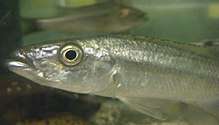Rhamphochromis
Rhamphochromis is a genus of East African haplochromine cichlids endemic to the Lake Malawi basin, including the main lake, Lake Malombe, Lake Chilingali, Chia Lagoon and upper Shire River.[1] They mainly occur in offshore open waters (down to depths of 200 m or 660 ft[2]), but a few species also near the coast.[3] They are piscivores that typically feed on lake sardines and small utaka cichlids.[3]
| Rhamphochromis | |
|---|---|
 | |
| Scientific classification | |
| Kingdom: | Animalia |
| Phylum: | Chordata |
| Class: | Actinopterygii |
| Order: | Cichliformes |
| Family: | Cichlidae |
| Tribe: | Haplochromini |
| Genus: | Rhamphochromis Regan, 1922 |
| Type species | |
| Hemichromis longiceps Günther, 1864 | |
They are elongated in shape and mainly silver or golden-silver in color, sometimes with yellow fins (especially pelvic and anal fins) and dark horizontal lines along the body. Depending on the species involved, they reach lengths of up to 28 to 45 cm (11–18 in).[4]
Although not closely related, they have sometimes been compared to piscivorous Bathybates cichlids of Lake Tanganyika.[5]
Species
There are currently six recognized species in this genus,[4] although the naming of these cichlids has been complicated. For example, FishBase states that Rhamphochromis lucius is almost certainly a synonym of R. woodi[6] whereas the Catalog of Fishes states that it is a synonym of R. esox.[7]
- Rhamphochromis esox (Boulenger, 1908)
- Rhamphochromis ferox Regan, 1922
- Rhamphochromis longiceps (Günther, 1864) (Tigerfish)
- Rhamphochromis lucius C. G. E. Ahl, 1926
- Rhamphochromis macrophthalmus Regan, 1922
- Rhamphochromis woodi Regan, 1922
The IUCN and the Catalog of Fishes recognise the following five species as valid within this genus:[7][8]
- Rhamphochromis brevis Trewavas, 1935
- Rhamphochromis esox (Boulenger, 1908)
- Rhamphochromis ferox Regan, 1922
- Rhamphochromis longiceps (Günther, 1864)
- Rhamphochromis woodi Regan, 1922
References
- Genner; Nichols; Carvalho; Robinson; Shaw; Smith; and Turner (2007). Evolution of a cichlid fish in a Lake Malawi satellite lake. Proceedings of the Royal Society B 274(1623). doi: 10.1098/rspb.2007.0619.
- Lowe-McConnell, R.H. (2003). Recent research in the African Great Lakes: Fisheries, biodiversity and cichlid evolution. Freshwater Forum 20(1): 4—64.
- Konings, Ad (1990). Ad Konings' Book of Cichlids and all the other Fishes of Lake Malawi. Pp. 458—464. ISBN 978-0866225274.
- Froese, Rainer and Pauly, Daniel, eds. (2017). Species of Rhamphochromis in FishBase. April 2017 version.
- Lindqvist, O.V.; H. Mölsä; K. Solonen; J. Sarvala, editors (1999). From Limnology to Fisheries: Lake Tanganyika and Other Large Lakes. Pp. 213—214. Springer. ISBN 978-0792360179
- Froese, Rainer and Pauly, Daniel, eds. (2018). "Rhamphochromis lucius" in FishBase. October 2018 version.
- Eschmeyer, W. N.; R. Fricke & R. van der Laan (eds.). "Rhamphochromis species". Catalog of Fishes. California Academy of Sciences. Retrieved 15 January 2019.
- "Rhamphochromis". IUCN. Retrieved 15 January 2019.
| Wikimedia Commons has media related to Rhamphochromis. |